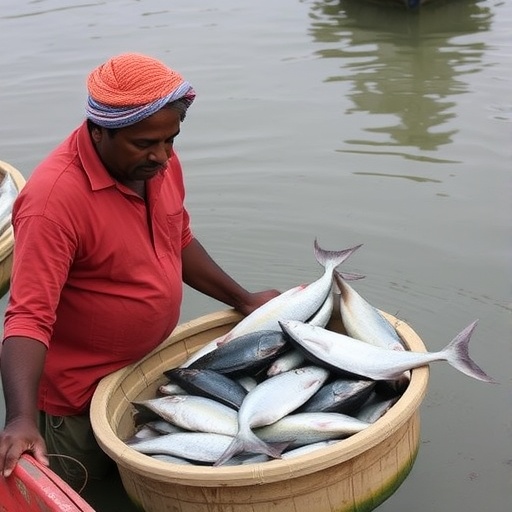In a groundbreaking study, researchers have delved deep into the intricate dynamics of the live fish supply chain in Tripura, India, revealing critical insights into stakeholder interactions, livelihood security, and vulnerability. This research, spearheaded by Paul, Das, and Shil, uncovers multifaceted challenges faced by various stakeholders, from fish farmers and traders to consumers and regulatory bodies. The live fish supply chain not only serves as a vital source of protein for many but also represents a significant economic activity in this region.
The study underlines the importance of understanding the interconnections between different stakeholders involved in the supply chain. For instance, fish farmers, who are often the initial point of production, are grappling with issues such as fluctuating fish prices, environmental sustainability, and regulatory compliance. The researchers highlight that these farmers, while essential to the supply chain, frequently operate under conditions of economic uncertainty and inadequate access to resources. This directly affects their ability to secure a sustainable livelihood and manage their operations effectively.
Moreover, the research emphasizes that traders play a crucial intermediary role in linking fish farmers to consumers. These traders, who purchase live fish from farmers and sell them in local markets or to larger distributors, face significant challenges themselves. Issues ranging from poor infrastructure to competition and market volatility significantly impact their livelihoods. The dynamics between traders and fish farmers are often characterized by bargaining power imbalances, highlighting an underlying vulnerability that permeates the entire supply chain.
Consumers, the final link in the supply chain, are influenced by various factors, such as price, availability, and quality of the fish products. The research notes that consumer behavior is also affected by cultural and regional preferences, which can vary significantly across Tripura and its neighboring regions. As the demand for fresh fish increases, understanding consumer preferences becomes crucial for adapting the supply chain to better meet these needs while ensuring sustainability.
The environmental component of the study cannot be overlooked. The researchers delve into how environmental challenges, such as climate change and water pollution, are increasingly impacting fish populations and, consequently, the livelihoods of those who depend on them. The urgency of addressing these environmental issues is paramount, as they threaten not only the supply of fish but also the broader ecological equilibrium essential for sustainable practices.
Vulnerability in the supply chain is a key focus of the research. The study identifies various sources of vulnerability ranging from economic shocks to natural disasters. These vulnerabilities are exacerbated for marginalized groups within the stakeholder community, including small-scale farmers and women. The authors argue that developing targeted strategies to empower these marginalized groups is essential in ensuring that the supply chain becomes more resilient.
Stakeholder dynamics are equally complex, with power relations and trust playing pivotal roles. The study points out that a lack of communication and trust among stakeholders can lead to misunderstandings and conflicts, ultimately disrupting the supply chain. Transparency and cooperation are critical in fostering a more collaborative environment where stakeholders can work together towards mutual benefits.
Through in-depth interviews, surveys, and field observations, the research provides a holistic view of the live fish supply chain in Tripura. The findings highlight the need for comprehensive policies that not only support fish farmers and traders but also incorporate environmental sustainability. Policymakers must be encouraged to engage in dialogue with stakeholders to create frameworks that ensure the long-term viability of this vital supply chain.
The implications of this study extend beyond Tripura. The insights gleaned from this research can be applied to similar supply chains in other regions, particularly in developing countries where fisheries are crucial to local economies. By understanding the unique dynamics at play within these systems, countries can formulate better policies to protect both livelihoods and natural resources.
Looking ahead, the researchers stress the importance of monitoring and evaluating the impact of any interventions implemented within this supply chain. Continuous engagement with stakeholders will be fundamental in adapting strategies to the evolving challenges posed by both market demands and environmental changes.
In conclusion, the research conducted by Paul, Das, and Shil provides a significant contribution to our understanding of the live fish supply chain in Tripura. By illuminating the challenges and dynamics at play among stakeholders, this study paves the way for informed policy decisions that can enhance livelihood security and reduce vulnerability, thereby ensuring the sustainability of this critical resource for future generations.
Through this comprehensive exploration, the researchers underscore the necessity of a coordinated approach that recognizes the interconnectedness of economic, social, and environmental factors. In doing so, they advocate for a more sustainable and equitable future for all players in the live fish supply chain, making the findings relevant not only for Tripura but for similar contexts around the globe.
Subject of Research: Dynamics of the live fish supply chain and stakeholder interactions in Tripura, India.
Article Title: Assessing stakeholder dynamics, livelihood security and vulnerability in live fish supply chain: study from Tripura, India.
Article References:
Paul, P.R., Das, R., Shil, S. et al. Assessing stakeholder dynamics, livelihood security and vulnerability in live fish supply chain: study from Tripura, India.
Discov Sustain 6, 1057 (2025). https://doi.org/10.1007/s43621-025-01952-w
Image Credits: AI Generated
DOI: 10.1007/s43621-025-01952-w
Keywords: live fish supply chain, Tripura, stakeholder dynamics, livelihood security, vulnerability, environmental sustainability.




